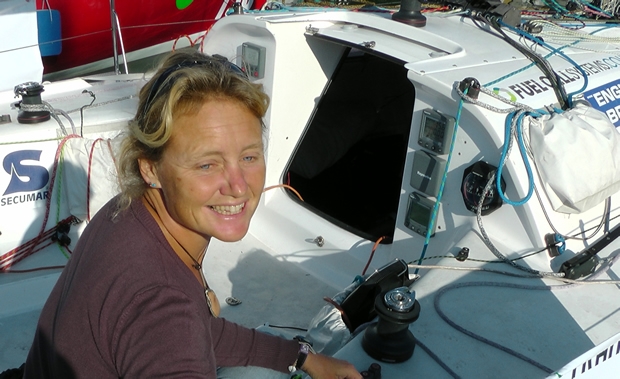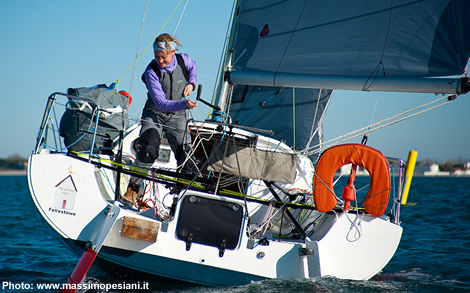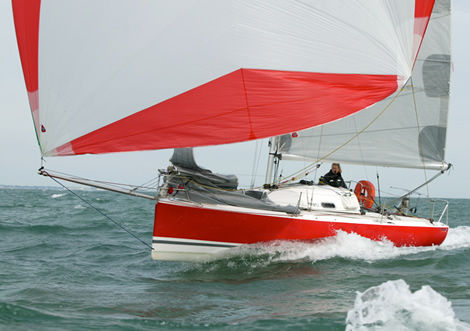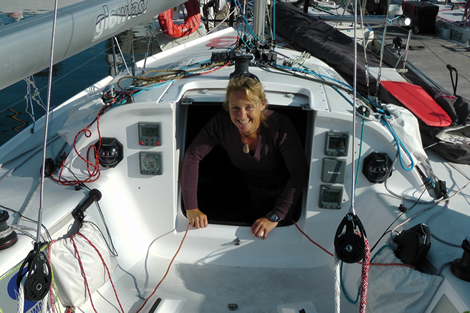
Pip Hare on the Mini Transat
With the Charente Maritime Bahia Transat 6.50 setting sail today, so Pip Hare, one of two British competitors in the 79 strong line-up of solo sailors heading off on the voyage to Salvador de Bahia via Funchal, Madeira tells us about how she tackles solo offshore racing in her Pogo2 Series class boat.
Sleep
“I have been asking a lot of people where they sleep and loads sleep inside, but I don’t unless it is really bad. I just sleep in the cockpit which is why my mainsheet is on the traveller, whereas loads of Pogo 2s have taken it back up to the boom and put a centre cleat in the middle of the cockpit. I didn’t do that for two reasons – I like the cockpit to be really clear for gybing and I like sleeping in the cockpit.”
So head up by the companionway? “Yes, that is the only place that you can get shelter on a Pogo2, even though the water just pours down the side on top of you. If it is upwind, then I do try and sit on the rail to sleep, but downwind I sleep in the cockpit next to the pilot because, depending on the breeze, but I am not looking at sleeping for longer than 20 minutes as it is too risky.”
Foul weather gear
“I am becoming of the opinion that it is impossible to keep dry on a Mini. This time I have got a Henri Lloyd offshore kit with dry seals at the neck and wrists. That is new, donated by Cazanove [Capital – her OSTAR sponsor]. I am a bit worried I am going to get sores where the rubber is if it is really bad.”
So you’ll live in that? “Pretty much. If the first leg is as upwind as it is looking like, I will. The biggest problem for a girl is just going to the loo, especially with a smock, if you have quite a bit on under the smock, it is just such an effort to get it off, so you have to be pretty strategic with your loo stops.
Do you take a funnel? “No. If it goes wrong you have got to sit in your own pee for weeks! So best not to try I think.”
Food
Moving swiftly on...What food are you taking? “I have one or two freeze dried [meals] a day, but I am also taking microwave pouches of lentils and that sort of thing. Then I have Crew Fuel. I am not taking any chocolate... When I wake up, usually I am really hungry, mostly because I’m cold, so I’ll just scoff a whole bar of chocolate and then I’ll get a big spike off it and I’ll feel rubbish about half an hour later and that is just completely the wrong way to eat, I just eat it because it is easy. Now I have a high energy mix from Crew Fuel, so instead when I wake up I’ll have that and occasionally I’ll have it with hot water and it is about 300 calories and it is slow release energy, so it is a much better way of eating. If chocolate is there, I’ll eat it, so I’m just not taking it.”
So what’s on the menu? “I have Woody’s leftovers [Andrew Wood – Mini Transat competitor in 2007 and 2009]. So vegetarian chilli and vegetable tikka and I have porridge in a bag.”
How much weight do you think you will lose? “I reckon I’ll lose 3 kilos.”
Entertainment
“Although I love listening to music when I’m sailing, I can’t bear not being able to hear the boat. If you are plugged into ear phones, you can’t hear if something’s rattling loose or there’s something not quite right. So I don’t take music and if I have any down time, I’ll write, I won’t read.”
As they are not allowed to take computers Pip will be having to write the old fashioned way...
Navigation
No computer and it’s wet down below, so how do you navigate?
“Just paper charts, on my knee. But it is quite nice. The first proper navigating/sailing/skippering experience I had was years ago with the Young Skippers Scheme out of Plymouth on a Hunter Duet with no engine, no navigation table, no GPS - so that’s how we navigated then, we just did it in our knees with floorboards. So it is going back to that.”
But with paper charts it is easy for them to get wet? You have charts laminated too? “I have a mix of both. I am going to do positions on paper charts and, if it is good conditions and I am getting the scheds through, then I’ll put other people’s positions on the paper charts as well. For the corners and for weather and for my general strategy, I have a road book printed out and laminated. Then for my weather I have little weather charts and the basic rules of the strategy are all printed out and laminated, so I have versions that can wet and that is the same for my sail change charts and my polars, etc.” Weather forecasts are transmitted to the fleet via HF radio and each boat carried an HF receiver for this purpose.
How wet does it get down below? “My boat is not too bad. I have to go and bail out every two hours or so, a half bucket full. I was having a lot of water coming in through the back hatch, but when I had my mini-refit I had the hatch seal redone, so hopefully there will be less water coming in there. And it comes in through the mast. But other than that, it is not too bad. Much better than some.”
Loneliness
How happy are you with the solitude, being on your own? “Very happy, in fact I can’t wait. that comes from doing lots of deliveries and it is the fourth time I will have done a transatlantic on my own. So I am pretty happy with that.”
So what are your fears then?
“I guess they are performance-related. Certainly it is not the crossing of the Atlantic - with that I am fine. And the boats are very very strong. With the Pogo2 I think there is no more risk of breaking stuff than there is with any other boat and those areas that are weak, then I have a spare pole [bowsprit] and a spare rudder. So I guess it is such a long build-up and it is such an effort financially, in terms of time, emotionally and if you make one silly mistake it is pretty difficult to come back from it. It can be that it is not an accurate reflection of the effort that has gone into it. But that is the nature of racing. It comes down to one result at the end.”
How competitive do you think you will be?
“I really don’t know. I know how I’d like to be, but the only event I have done with the whole fleet is the Select [Pornichet] and then I had a problem with my batteries and I was down the pan in that. I would hope that my experience is going to count for something, so although I am not that familiar with the boat I would hope that my familiarity with ocean sailing is going to come into its own at some point, maybe on the second leg when we have been at sea for 12 days it is going to kick in and will pull me some of the way up. I would hope to be in the top 15.”
Support
How much help have you have from the marine industry?
“In terms of sponsored kit, the help from the marine industry has been brilliant – English Braids, Raymarine and Flag Finishes who make my antifouling – they sponsored me from the beginning in the OSTAR and the RBR. Secumar sponsored me for my safety kit and then Glowfast have given me draft stripes for the main and the jib.
And how have you found the class? There is a good exchange of kit and knowledge?
“It is a really, really friendly class. People are very welcoming and they will lend you stuff, but everything has a price though. Everyone in the class is struggling [financially]. They will sell you something or you can sell something. But within our group from CEM [the Centre d’Entrainement Mediterranée in La Grande-Motte where the Artemis Offshore Academy train over the winter] we all look after each other. So I have given one person a spare rudder and I’ll lend my mainsail to someone because I know they don’t have any money. I think it is the most friendly class I’ve ever sailed in. And I have found going around talking to the other Pogo2 sailors...I would never have thought to check my rudders, and I spoke to someone at the UK Fastnet, and he said they might break. And he was right because one of them was half broken - I wouldn’t have done that if he hadn’t told me too.” Pip fitted two new rudders the week before the start.
How much gear have you broken?
“I am on my third bowsprit, but that was user error... They have beefed them up, but the reason you break them is from trawling the kite. If you trawl the kite and don’t immediately let the guy off, it is pulling the pole back and it breaks on the bit where it slots on, so Keith [Willis, former Mini competitor] told me when I first got the boat, not to have any screws in the inboard end because that will break it and I didn’t take them out and that was the first thing I broke...but there is an answer – don’t trawl the kite!”
The Pogo 2 is not the newest of the Series boats. Can one still win? (In the last Mini Transat Portugal’s Francisco Lobato finished third overall in the opening leg down to Madeira aboard his Pogo2).
“In the right conditions, if it is windy. The Pogo 2 is just a tank. When it gets too windy then the Protos start struggling and they start backing off because they can’t afford to break stuff and a Pogo 2 just goes on and on and on and upwind when it is windy they just bash through the waves. Pierre on 552 [Brasseur, skipper of Voiles Ocean], he is gunning to win. Otherwise everyone’s money is on a Nacira [the newest of the Series boats].”
What is the range of budgets in the Series class?
“I think probably one of the lowest budgets would be the guy who is racing with the Pogo 1. That is a boat you can buy for 25-26,000 Euros. So the smallest budget, including the boat, would be about 35,000.”
And to be competitive in the Series class? “It is pretty open ended. I reckon you could spend about 100,000 Euros. 60,000 would be an average figure which would get you new sails and a fuel cell and that sort of thing.
Then you can sell the boat afterwards?
“Yes and get the money back from there... I spent more money than a lot of people because of the way that I qualified. I had to do the first three races of the season and that was a really expensive couple of months. If you just based your boat in Lorient and did the Demi Cle and the Select and the [Mini] Fastnet, then there wouldn’t be any travelling involved, but because I had to do the Italian races and then get back up to France for the Select, I did 10,000 miles towing the boat on a trailer. And that is quite expensive.”
Are there any peculiarities with sailing a Pogo 2?
“You do sail them with quite an angle of heel on, which seems odd at times. I have been used to a critical angle of heel and not allowing the boat to heel any more than that. You are stacking like crazy to try and get the boat flat, but in medium breeze it does go better with what seems like too much angle of heel on it.”
Sails
What decisions do you have to make about the sails? A lot of your headsails are reefing?
“The biggest one for me is the headsail. I made a decision, which is maybe a bit different from other people. I started off with a Solent and after I wrecked that on my qualifier, I got a sail called an ‘Inter’ which is outside sheeting and it is overlapping at the bottom, but its leach is cut so that when you reef it becomes inside sheeting. It is not that much bigger than a Solent, maybe 1sqm bigger, but it has got this long foot on it and that is the sail of choice for everybody. But I just couldn’t get on with it - its windward performance is just awful and the big problem is the balance because when you get to the point where you should be reefing, it is not immediately obvious whether you should be reefing the mainsail or the Inter and then, particularly if you have any chop or swell, the helm just becomes so unbalanced. There was no natural feeling as to how to trim it, which sail should be reefed when, etc. So I went smaller and have gone for a Solent, which is inside sheeting and it goes so much nicer into the breeze and the boat copes with swell and chop much better as a result. Whether or not it was the right sail choice, I think it is more important for me to be able to sail the boat. The Solent is reef-able but it is a smaller sail, which in view of the start being upwind, I am quite happy about.
Apart from your mainsail how many other of your sails are reefable?
“I have a reefable spinnaker. There are quite a few people with reef-able spinnakers, so you are effectively taking three spinnakers. You have got the big one - my one is 75sqm and masthead - and then the medium one is 68sqm and it is 54sqm with the reef in it. Full, it is masthead, reefed, it is fractional. We had a completely removable bottom piece which is not allowed. [So the sail was changed so that when reefed the foot of the sail zips into itself].
Pilots
What type of autopilots do you use and how well do they work?
“I am really pleased with my pilot. Upwind, if I am tired, my pilot is better than I am. Downwind they cope really well, but they are not as good as I am, because they can’t see ahead. But they are good. They are Raymarine ones and I have two completely separate pilot systems with all of the components interchangeable between them. I have four rams, so there shouldn’t be any problems with that, and I have put in a rudder reference unit which does make quite a difference to the performance but they don’t like getting wet so I did a very technical alteration and made it a little hat out of the bottom of a Coke bottle...”












Latest Comments
Add a comment - Members log in